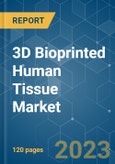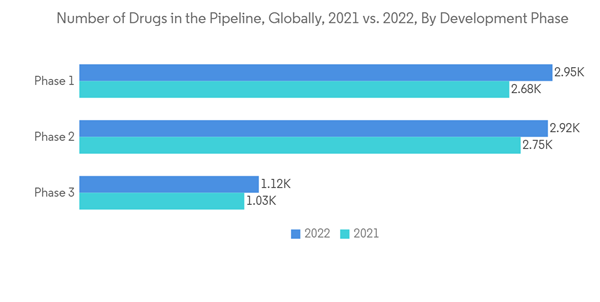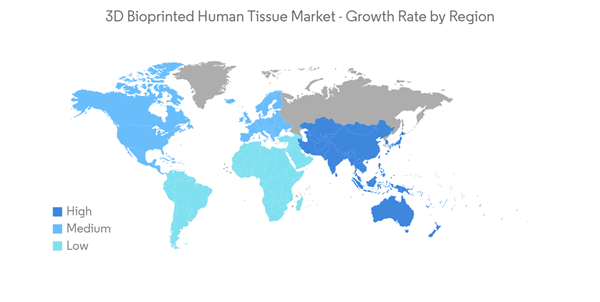The COVID-19 pandemic has spread across various countries, leading to a global health system overload. The increasing number of patients, along with supply chain disruption, generated a shortage of medical devices and personal protective equipment. As per an April 2021 published article by Medical Device + Diagnostic Industry (MD+DI), in the battle against COVID-19, 3D printer companies specializing in a range of services pivoted their technology and designs to support relief efforts, mass-producing medical products essential for providers in a pandemic. As shortages of personal protective equipment persisted during the coronavirus pandemic, 3D printing helped to alleviate some of the gaps.
However, according to a New York Times article published in July 2020, Wake Forest Institute for Regenerative Medicine used the process more innovatively, creating tiny replicas of human organs, some as small as a pinhead, to test drugs to fight COVID-19. Owing to the increasing 3D printing innovation in drug testing for COVID-19, the market is likely to continue its significant growth rate during the forecast period at a pre-pandemic rate.
Specific factors driving the market growth include technological advancements leading to enhanced application and rising demand for customized 3D bioprinted tissue engineering and organ replacement. An article published by ScienceDirect in March 2022 states that 3D bioprinting has served as a promising approach for engineering complex tissues, offering precise control over cellular building blocks to recapitulate the intricate hierarchy and complexity of native human tissues.
Recent advancements in the innovative forms of living building blocks and enabling bioprinting techniques have greatly expanded the capability to engineer more complex and functional tissues, and further extend their applications in engineering disease models, microphysiological systems, and biobots. Furthermore, according to an article published by Science Daily in March 2021, researchers at Lund University in Sweden have designed a new bio-ink that allows small human-sized airways to be 3D bioprinted with the help of patient cells. The 3D-printed constructs are biocompatible and support new blood vessel growth into the transplanted material. Therefore, such advancements are expected to increase the demand for 3D bioprinted human tissues, thus driving the market.
Furthermore, the increasing product innovation and collaborations funded by the key market players and government agencies will support the market growth over the forecast period. In November 2022, Northrop Grumman’s 18th Commercial Resupply Services (NG-18) mission launched an upgraded version of Redwire Space’s BioFabrication Facility (or BFF), a 3D bioprinter capable of printing human tissue. The project, sponsored by the ISS National Laboratory, paved the way for in-space bioprinting tissues to help patients back on Earth. Such product innovations are also adding to the growth of the market.
Thus, the abovementioned factors are impacting the market growth of the 3D bioprinted human tissue market. However, the shortage of skilled professionals and the absence of specific regulatory guidelines are expected to hinder market growth over the forecast period.
3D Bioprinted Human Tissue Market Trends
Drug Testing and Development Expected to Hold Significant Market Share
3D bioprinted human tissue has significant importance in drug testing. 3D bioprinted human tissue is highly important for drug testing and clinical trial applications. They are expected to drastically reduce the need for animal trials, thus being ethically beneficial and cost-effective. Traditionally, clinical trials for new drug development involved testing on animals with artificially-induced affected tissues. With the advent of 3D bioprinted human tissue, drug developers can address the complications associated with human clinical trials of new drugs by identifying them in a short period (since these can be tested with human-like 3D printed tissues), thus reducing the losses incurred during late-stage failures. For instance, according to an article published by the National Library of Medicine, in September 2021, 3D printing improves the existing drug screening platforms by accurately depositing biomaterials containing patient-derived cells and can reproduce the natural environment of the diseased human body.Lack of safety and efficacy are the principal causes of the failure of the drugs, which become evident only in Phases II and III of clinical trials. The 3D bioprinted organs can identify the side effects of drugs and help medicine developers to streamline safe drug dosages to be administered to humans, as this technology allows for short drug discovery time. The regulatory agency of the US Food and Drug Administration is considering integrating alternatives for drug safety and efficacy assessment, providing scope for the market. For instance, in December 2021, FDA issues a discussion paper that provides background information on 3D printing and proposes potential point-of-care manufacturing scenarios for public comment. Such initiatives are expected to drive the growth of the market.
Thus, given the aforementioned factors, the drug testing segment is expected to propel significantly over the forecast period.
North America Expected to Dominate the 3D Bioprinted Human Tissue Market
Due to high technology adoption, the North American region is expected to dominate the 3D bioprinted human tissue market. A series of new product launches and innovations are expected to augment market growth further. Several 3D bioprinting solution providers worldwide are expanding their presence in the North American market for an enhanced market presence.In July 2022, the United States Ohio State University, in collaboration with Nexxt Spine, LLC, initiated a clinical trial to evaluate and compare radiographic and clinical outcomes in patients who are to undergo combined interbody/posterolateral lumbar fusion procedures, supplemented with pedicle screw instrumentation, using the Nexxt Spine, Nexxt Matrixx 3D printed titanium cage or the Honour poly-ether-ether-ketone cage. Such collaborations are expected to drive the market.
Furthermore, increasing strategic initiatives are also contributing to the market's growth. For instance, in March 2022, 3D LifePrints launched point-of-care medical 3D printing services in the United States. The company received funding to support its growth in domestic and international regions. Additionally, in February 2022, Organovo Holdings, Inc. BICO announced an agreement on a broad license for BICO and its affiliate companies to Organovo’s foundational patent portfolio in 3D bioprinting. Such strategic initiatives are expected to drive the growth of the market.
Thus, the abovementioned factors are expected to drive market growth in the North American region during the forecast period.
3D Bioprinted Human Tissue Market Competitor Analysis
The 3D bioprinted human tissue market is moderate due to the presence of companies operating globally and regionally. The competitive landscape includes an analysis of well-known companies which hold market shares, including 3D Systems, Inc., Materialise NV, Oceanz 3D printing, Organovo, Prellis Biologics, SOLS Systems, and Stratasys Ltd, among others.Additional benefits of purchasing the report:
- The market estimate (ME) sheet in Excel format
- 3 months of analyst support
This product will be delivered within 2 business days.
Table of Contents
Companies Mentioned (Partial List)
A selection of companies mentioned in this report includes, but is not limited to:
- 3D Systems, Inc.
- Materialise NV
- Oceanz 3D printing
- Organovo
- Prellis Biologics
- SOLS Systems
- Stratasys Ltd
- The Pexion Group










